Festo CPX-FB14 Handleiding
Festo
Niet gecategoriseerd
CPX-FB14
Bekijk gratis de handleiding van Festo CPX-FB14 (3 pagina’s), behorend tot de categorie Niet gecategoriseerd. Deze gids werd als nuttig beoordeeld door 2 mensen en kreeg gemiddeld 4.4 sterren uit 1.5 reviews. Heb je een vraag over Festo CPX-FB14 of wil je andere gebruikers van dit product iets vragen? Stel een vraag
Pagina 1/3

CPX bus node CANopen
CPX-FB14
Festo SE & Co. KG
Ruiter Straße 82
73734 Esslingen
Germany
+49 711 347-0
www.festo.com
Brief description
Translation of the original instructions
8101627
2018-11c
[8101629]
CPX bus node CANopen CPX-FB14 English. . . . . . . . . . . . . . . . . . . . . . . . . . . . . . . .
For all available product documentation è www.festo.com/pk
1 User instructions
The bus node CPX-FB14 for CPX terminals is intended exclusively for use as a parti
cipant (Slave) in a CANopen network.
The specified limits for technical data must be adhered to. You can find detailed
information in the bus node description P.BE-CPX-FB14-... and in the CPX system
description P.BE-CPX-SYS-.…
CANopen
®
and TORX
®
are registered trademarks of the respective trademark
owners in certain countries.
Warning
Switch off the power supply before assembling or disassembling modules or
plugging plug connectors together or separating them (danger of operative
malfunctions or damage).
Only use PELV circuits in accordance with IEC/EN 60204-1 (protective extra-
low voltage, PELV) for the electrical power supply.
Observe also the general requirements for PELV power circuits in accordance
with IEC/EN 60204-1.
Only use voltage sources which guarantee reliable electrical isolation of the
operating voltage in accordance with IEC/EN 60204-1.
Connect an earth conductor of sufficient cable cross section to the connection
of the CPX terminal marked with the earth symbol.
Note
The CPX bus node contains electrostatically sensitive devices.
Therefore, do not touch any components.
Observe the handling specifications for electrostatically sensitive devices.
This will help to prevent damage to the electronics
Note
Only commission a CPX terminal which has been completely mounted and
connected.
2 Connection and display components
MS PS
PL
SF
M
NS
IO
51
96
1
2
4
3
1Bus-status-specific and
CPX-specific LEDs
2Fieldbus connection (9-pin Sub-D
plug)
3Cover for DIL switches
4Service interface for handheld,
etc.
Fig. 1
CANopen-specific LEDs CPX-specific LEDs
MS Module status (green/red)
1)
PS Power system (green)
1)
NS Network status (green/red)
1)
PL Power load (green)
1)
IO I/O status (green/red)
1)
SF System failure (red)
1
)
M Modify (yellow)
1)
2)
1) P.BE-CPX-FB14-…Detailed information: è bus node description
2) Parameterisation revised or “Force” active
Fig. 2
Normal operating status:
The LEDs MS, NS, IO, PS and PL light up green; the LEDs SF and M do not light up.
3 Installation instructions
3.1 Mounting/dismounting
When built-in, the bus node is located in an interlinking block of the CPX terminal.
3
1
2
4
1TORX T10 screws; tightening
torque 0.9…1.1 Nm
2Bus node CPX-FB14
3Contact rails
4Interlinking block
Fig. 3
Warning
Switch off the power supply before assembling or disassembling bus nodes
(danger of operative malfunction or damage).
Dismantling:
Unscrew screws and carefully lift off the bus node.

Mounting:
1. Check seal and seal surfaces.
2. Carefully insert connection block into the interlinking block and press it in.
3. Screws must be set so that the existing self-cutting threads can be used.
Tighten the screws by hand in diagonally opposite sequence. Tightening
torque: 0.9 … 1.1 Nm
Note
Always use the appropriate screws for the interlocking block, which depend on
the material of the interlinking block (metal or plastic):
Plastic interlinking block: thread-cutting tapping screws
Metal interlinking block: screws with metric thread
3.2 Setting the DIL switches
1 2 3 4 5 6 7 8
1 2 1 2
On On
1 2 1 2
On On
On
1
2
3
4
5
1DIL switch 1: bus node operating mode
2DIL switch 2: undervoltage error message mode
3DIL switch 3 station number/LSS activation
4DIL switch 4 baud rate
5DIL switch 5 CPX diagnostics mode or number of log. I/Os with “remote
controller”
Fig. 4
Setting the operating mode with DIL switch 1
You can set the operating mode of the bus node with switch element 1.1 of the
dual DIL switch 1:
DIL switch 1Function
DIL 1.1: OFF
DIL 1.2: OFF
(factory setting)
Remote I/O operating mode
All functions of the CPX terminal are controlled
directly by the CANopen Master.
DIL 1.1: ON
DIL 1.2: OFF
Remote Controller
A CPX-FEC or CPX-CEC integrated into the terminal
controls all functions
Fig. 5
Setting the fault mode with DIL switch 2
Set the fault mode with the dual DIL switch:
DIL switch 2Function
DIL 2.1: OFF
DIL 2.2: OFF
1)
(factory setting)
Registering undervoltage error
DIL 2.1: ON
DIL 2.2: OFF
1)
Filtering undervoltage error
Faults during the monitoring of the operating and load
voltage supplies will be ignored
1) The setting of the switch element DIL 2.2 is reserved (always OFF).
Fig. 6
Setting the station number with DIL switch 3
Set the station number using the switch elements 1 ... 7 of the 8-element DIL
switch:
DIL switch 3Function
1 2 3 4 5 6 7 8
2
0
2
1
2
2
2
3
2
4
2
5
2
6
DIL 3.8 Resetting the bus node to factory setting
( Fig. 9).è
DIL 3.1 … DIL3.7 Binary-coded input of the station number.
Example on left in diagram:
2
1
+ 2
2
+ 2
5
=
2 + 4 + 32 = station number 38
Permissible station numbers: 1 … 127
Fig. 7
Activation of the layer setting service with DIL switch 3
The bus node CPX-FB14 supports layer setting service (LSS) in accordance with
CiA DSP-305.
To activate LSS, set the switch elements 1 … 7 of the DIL switch to OFF (station
number = 0):
DIL switch 3
Function
1 2 3 4 5 6 7 8
2
0
2
1
2
2
2
3
2
4
2
5
2
6
DIL 3.8 Resetting the bus node to factory setting
( Fig. 9).è
DIL 3.1 … DIL 3.7 Binary-coded input of the station number.
Example in the left figure:
Station number = 0, LSS is activated
Fig. 8
Resetting the bus node to factory setting with DIL switch 3
Reset the bus node to factory setting with switch element 8 of the DIL switch:
DIL switch 3Function
1 2 3 4 5 6 7 8
2
0
2
1
2
2
2
3
2
4
2
5
2
6
DIL 3.8 Resetting the bus node to factory setting:
1. Switch off the power supply for the CPX
terminal.
2. Set the DIL switch 8 to ON.
3. Switch on the power supply for the CPX
terminal.
The bus node is reset to factory settings.
4. Set the DIL switch 8 back to OFF.
DIL 3.1 … DIL3.7 Binary-coded input of the station number
( Fig. 7)è
Fig. 9
Setting the baud rate with DIL switch 4
Set the baud rate with the dual DIL switch:
DIL switch 4
125 kbaud 250 kbaud 500 kbaud 1000 kbaud
DIL 4.1: OFF
DIL 4.2: OFF
DIL 4.1: ON
DIL 4.2: OFF
DIL 4.1: OFF
DIL 4.2: ON
DIL 4.1: ON
DIL 4.2: ON
2)
Fig. 10

Setting the CPX diagnostic mode or the number of logical I/Os (data field size)
with DIL switch 5
The function of DIL switch 5 is dependent on the set operating mode of the CPX
terminal. Set the CPX diagnostics mode or the number of logical I/Os with the dual
DIL switch:
DIL switch 5
Function in Remote
I/O operating mode
Function in Remote
Controller operating
mode
Diagnostics mode Number of I/O bytes
DIL 2.1: OFF
DIL 2.2: OFF
(factory setting)
Status bits and I/O
diagnostics interface
deactivated
Reserved
DIL 2.1: ON
DIL 2.2: OFF
Status bits activated
(8 bit)
DIL 2.1: OFF
DIL 2.2: ON
I/O diagnostics interface
(16 bit)
DIL 2.1: ON
DIL 2.2: ON
Reserved 8 byte (64 bit)
Fig. 11
3.3 Pin allocation, fieldbus interface
Plug Pin Internal
contacting
CANopen
51
96
1
2
3
4
5
6
7
8
9
Housing
(Plug)
FE
Not connected
CAN_L
CAN_GND
Not connected
CAN_SHLD
GND
CAN_H
Not connected
CAN_V+
Fig. 12
3.4 Power supply of the CPX terminal
The operating and load voltage supply for the CPX terminal is fed in via interlinking
blocks. The interlinking blocks carry the operating and load voltage over contact
rails to the adjacent modules.
FE0V24 V24V
1 2 3 4 2 3 4
0V FE24V
1
n.c.
24 V
VAL
0 V
VAL
24 V
EL/SEN
0 V
EL/SEN
24 V
OUT
0 V
OUT
FE
24 V
OUT
0 V
OUT
1 2 3
4
5
6
7
M18 M18
1Interlinking block with system
supply, e.g. type CPX-GE-EV-S
2Interlinking block without supply,
e.g. type CPX-GE-EV
3Interlinking block with additional
power supply, e.g. type
CPX-GE-EV-Z
4Load voltage for valves
5Operating voltage for electronics
and sensors
6Load voltage for digital outputs
7Functional earth (FE), with earth
terminal connected to the end
plate, and also to the housing, if
metallic design
Fig. 13
Example of connection
The following figure shows as an example the connection for a system supply and
an additional supply (each with M18 plugs) for electric outputs.
1
2 3 4 5 6
2 4
M18
M18
1Potential equalisation
2External fuses
3The load voltage for the
valves/outputs can be switched
off separately
4Earth terminal pin 4 (M18 plug),
designed for 16 A
5Connection of the system power
supply type CPX-GE-EV-S (M18)
6Connection of the additional
supply for electric outputs type
CPX-GE-EV-Z (M18)
Fig. 14
3.5 Start-up behaviour of the CPX terminal
If the LED M illuminates or flashes permanently after the system start, “System
start with saved parameterisation and saved CPX expansion” is set or “Force” is
active.
3.6 Note on module replacement
Caution
For CPX terminals with a continuously shining or flashing LED M, the paramet
erisation is not automatically created by the higher-level system when the
CPX terminal is replaced during servicing. In this case, verify which settings are
required before replacement and restore these settings after replacement.
Additional information on parameterisation and start-up behaviour
of the CPX terminal can be found in the bus node description P.BE-
CPX-FB14-...
You can find information on CANopen in the Internet:
CAN in Automation (CiA) è http://www.can-cia.org
4 Technical data
Type CPX-FB14
General technical data è CPX system description P.BE-CPX-SYS-...
Protection class through housing
according to IEC/EN 60529, completely
mounted, plug connector inserted or
provided with cover cap
IP65 (fully assembled)
Protection against electric shock
Protection against direct and indirect contact
as per IEC/DIN 60204-1
By means of PELV power circuit
Bus node intrinsic current consumption
from operating voltage supply for
electronics/sensors (U
EL/SEN
)
Max. 200 mA at 24 V (internal electronics)
Separation
CANopen interfaces to U
EL/SEN
Galvanically isolated
Fig. 15
Product specificaties
| Merk: | Festo |
| Categorie: | Niet gecategoriseerd |
| Model: | CPX-FB14 |
Heb je hulp nodig?
Als je hulp nodig hebt met Festo CPX-FB14 stel dan hieronder een vraag en andere gebruikers zullen je antwoorden
Handleiding Niet gecategoriseerd Festo

2 Augustus 2025
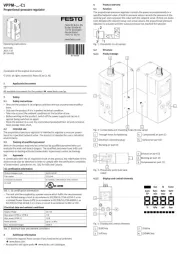
2 Augustus 2025
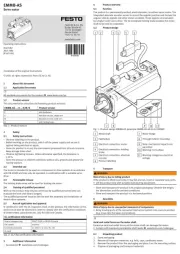
1 Augustus 2025
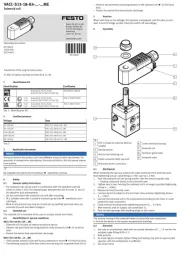
1 Augustus 2025
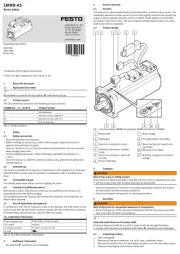
1 Augustus 2025
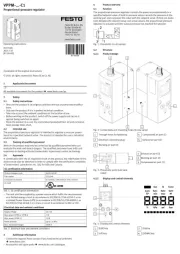
1 Augustus 2025
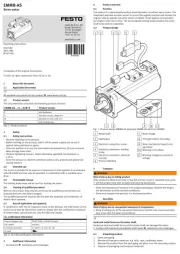
1 Augustus 2025
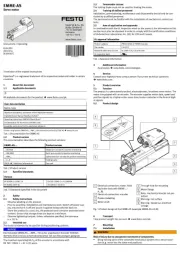
1 Augustus 2025
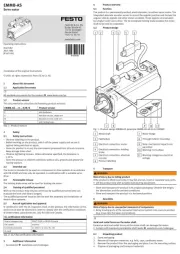
1 Augustus 2025
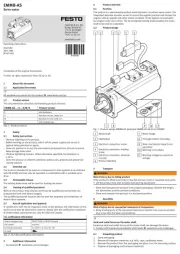
1 Augustus 2025
Handleiding Niet gecategoriseerd
- VCM
- CEDAR
- AEA
- AS Synthesizers
- Hugo Muller
- BBB
- Luxli
- Ultron
- Blaser
- Slingshot
- TOTO
- Goldtouch
- AmpliVox
- Silver Cross
- Imperia
Nieuwste handleidingen voor Niet gecategoriseerd
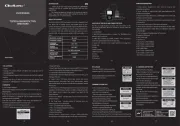
13 September 2025
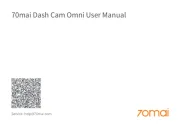
13 September 2025

13 September 2025
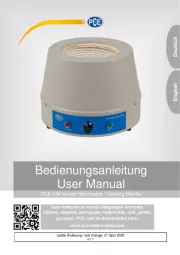
13 September 2025

13 September 2025
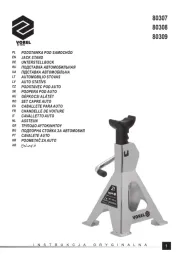
13 September 2025
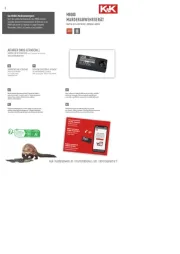
13 September 2025
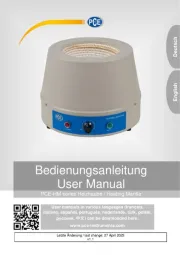
13 September 2025

13 September 2025
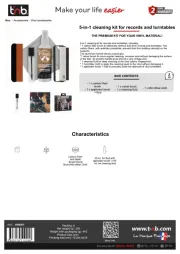
13 September 2025